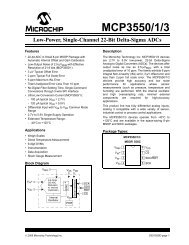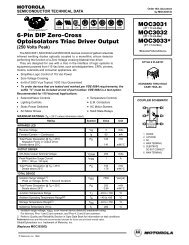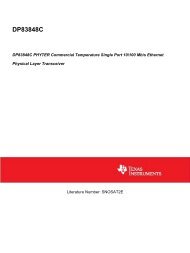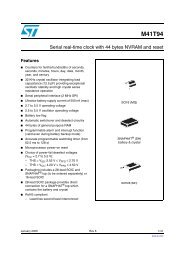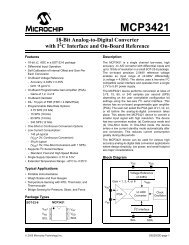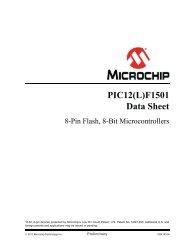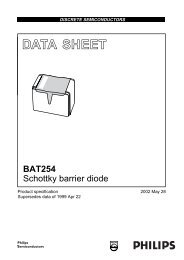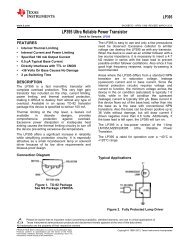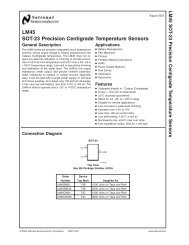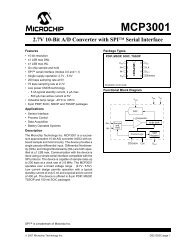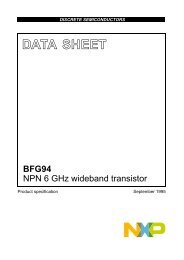- Page 1 and 2: Features8/16-bit Atmel XMEGA A3U Mi
- Page 4 and 5: 3. OverviewThe Atmel AVR XMEGA is a
- Page 6 and 7: 4. ResourcesA comprehensive set of
- Page 8 and 9: The arithmetic logic unit (ALU) sup
- Page 10 and 11: Six of the 32 registers can be used
- Page 12 and 13: 7.3.4 Production Signature RowThe p
- Page 14 and 15: 7.8 Data Memory and Bus Arbitration
- Page 16 and 17: 8. DMAC - Direct Memory Access Cont
- Page 18 and 19: Figure 9-1.Event system overview an
- Page 20 and 21: Figure 10-1. The clock system, cloc
- Page 22 and 23: 11. Power Management and Sleep Mode
- Page 24 and 25: 12. System Control and Reset12.1 Fe
- Page 28 and 29: Program address(base address) Sourc
- Page 30 and 31: 15.3.1 Push-pullFigure 15-1. I/O co
- Page 32 and 33: 15.4 Input sensingInput sensing is
- Page 34 and 35: Only Timer/Counter 0 has the split
- Page 36 and 37: 18. AWeX - Advanced Waveform Extens
- Page 38 and 39: 20. RTC - 16-bit Real-Time Counter2
- Page 40 and 41: Multipacket transfer enables a data
- Page 42 and 43: 23. SPI - Serial Peripheral Interfa
- Page 44 and 45: 25. IRCOM - IR Communication Module
- Page 46 and 47: 28. ADC - 12-bit Analog to Digital
- Page 48 and 49: 29. DAC - 12-bit Digital to Analog
- Page 50 and 51: 30. AC - Analog Comparator30.1 Feat
- Page 52 and 53: 31. Programming and Debugging31.1 F
- Page 54 and 55: TXDnSSMOSIMISOSCKTransmitter Data f
- Page 56 and 57: Table 32-3.Port C - alternate funct
- Page 58 and 59: 33. Peripheral Module Address MapTh
- Page 60 and 61: 34. Instruction Set SummaryMnemonic
- Page 63 and 64: Mnemonics Operands Description Oper
- Page 65 and 66: 35. Packaging information35.1 64API
- Page 67 and 68: 36. Electrical CharacteristicsAll t
- Page 69 and 70: 36.1.3 Current consumptionTable 36-
- Page 71 and 72: 36.1.4 Wake-up time from sleep mode
- Page 77 and 78:
Symbol Parameter Condition Min. Typ
- Page 79 and 80:
Table 36-21. Programming time.Symbo
- Page 81 and 82:
t CRV IH1V IL1t CLt CK36.1.14.6 Ext
- Page 83 and 84:
Symbol Parameter Condition Min. Typ
- Page 85 and 86:
36.1.15 SPI CharacteristicsFigure 3
- Page 87 and 88:
36.1.16 Two-Wire Interface Characte
- Page 89 and 90:
36.2 ATxmega128A3U36.2.1 Absolute M
- Page 91 and 92:
36.2.3 Current consumptionTable 36-
- Page 93 and 94:
36.2.4 Wake-up time from sleep mode
- Page 95 and 96:
36.2.6 ADC characteristicsTable 36-
- Page 97 and 98:
Symbol Parameter Condition Min. Typ
- Page 99 and 100:
Symbol Parameter Condition Min. Typ
- Page 101 and 102:
Table 36-53. Programming time.Symbo
- Page 103 and 104:
t CRV IH1V IL1t CLt CK36.2.14.6 Ext
- Page 105 and 106:
Symbol Parameter Condition Min. Typ
- Page 107 and 108:
36.2.15 SPI CharacteristicsFigure 3
- Page 109 and 110:
36.2.16 Two-Wire Interface Characte
- Page 111 and 112:
36.3 ATxmega192A3U36.3.1 Absolute M
- Page 113 and 114:
36.3.3 Current consumptionTable 36-
- Page 115 and 116:
36.3.4 Wake-up time from sleep mode
- Page 117 and 118:
36.3.6 ADC characteristicsTable 36-
- Page 119 and 120:
Symbol Parameter Condition Min. Typ
- Page 121 and 122:
Symbol Parameter Condition Min. Typ
- Page 123 and 124:
Table 36-85. Programming time.Symbo
- Page 125 and 126:
t CRV IH1V IL1t CLt CK36.3.14.6 Ext
- Page 127 and 128:
Symbol Parameter Condition Min. Typ
- Page 129 and 130:
36.3.15 SPI CharacteristicsFigure 3
- Page 131 and 132:
36.3.16 Two-Wire Interface Characte
- Page 133 and 134:
36.4 ATxmega256A3U36.4.1 Absolute M
- Page 135 and 136:
36.4.3 Current consumptionTable 36-
- Page 137 and 138:
36.4.4 Wake-up time from sleep mode
- Page 139 and 140:
36.4.6 ADC characteristicsTable 36-
- Page 141 and 142:
Symbol Parameter Condition Min. Typ
- Page 143 and 144:
Symbol Parameter Condition Min. Typ
- Page 145 and 146:
Table 36-117.Programming time.Symbo
- Page 147 and 148:
t CRV IH1V IL1t CLt CK36.4.14.6 Ext
- Page 149 and 150:
Symbol Parameter Condition Min. Typ
- Page 151 and 152:
36.4.15 SPI CharacteristicsFigure 3
- Page 153 and 154:
36.4.16 Two-Wire Interface Characte
- Page 155 and 156:
37. Typical Characteristics37.1 ATx
- Page 157 and 158:
Figure 37-5. Active mode supply cur
- Page 159 and 160:
Figure 37-9. Idle mode supply curre
- Page 161 and 162:
Figure 37-13. Idle mode supply curr
- Page 163 and 164:
37.1.1.4 Power-save mode supply cur
- Page 165 and 166:
Figure 37-21. I/O pin pull-up resis
- Page 167 and 168:
Figure 37-25. I/O pin output voltag
- Page 169 and 170:
Figure 37-29. I/O pin output voltag
- Page 171 and 172:
Figure 37-33. I/O pin input thresho
- Page 173 and 174:
Figure 37-37. INL error vs. input c
- Page 175 and 176:
Figure 37-41. Gain error vs. V REF
- Page 177 and 178:
Figure 37-45. Offset error vs. V CC
- Page 179 and 180:
Figure 37-49. DNL error vs. V REF .
- Page 181 and 182:
Figure 37-53. Analog comparator hys
- Page 183 and 184:
Figure 37-57. Voltage scaler INL vs
- Page 185 and 186:
37.1.8 External Reset Characteristi
- Page 187 and 188:
Figure 37-65. Reset pin input thres
- Page 189 and 190:
37.1.10 Oscillator Characteristics3
- Page 191 and 192:
Figure 37-72. 2MHz internal oscilla
- Page 193 and 194:
Figure 37-76. 32MHz internal oscill
- Page 195 and 196:
Figure 37-80. 48MHz internal oscill
- Page 197 and 198:
37.2 ATxmega128A3U37.2.1 Current co
- Page 199 and 200:
Figure 37-88. Active mode supply cu
- Page 201 and 202:
Figure 37-92. Idle mode supply curr
- Page 203 and 204:
Figure 37-96. Idle mode supply curr
- Page 205 and 206:
37.2.1.4 Power-save mode supply cur
- Page 207 and 208:
Figure 37-104. I/O pin pull-up resi
- Page 209 and 210:
Figure 37-108. I/O pin output volta
- Page 211 and 212:
Figure 37-112. I/O pin output volta
- Page 213 and 214:
Figure 37-116. I/O pin input thresh
- Page 215 and 216:
Figure 37-120. INL error vs. input
- Page 217 and 218:
Figure 37-124. Gain error vs. V REF
- Page 219 and 220:
Figure 37-128. Offset error vs. V C
- Page 221 and 222:
Figure 37-132. DNL error vs. V REF
- Page 223 and 224:
Figure 37-136. Analog comparator hy
- Page 225 and 226:
Figure 37-140. Voltage scaler INL v
- Page 227 and 228:
37.2.8 External Reset Characteristi
- Page 229 and 230:
Figure 37-148. Reset pin input thre
- Page 231 and 232:
37.2.10 Oscillator Characteristics3
- Page 233 and 234:
Figure 37-155. 2MHz internal oscill
- Page 235 and 236:
Figure 37-159. 32MHz internal oscil
- Page 237 and 238:
Figure 37-163. 48MHz internal oscil
- Page 239 and 240:
37.3 ATxmega192A3U37.3.1 Current co
- Page 241 and 242:
Figure 37-171. Active mode supply c
- Page 243 and 244:
Figure 37-175. Idle mode supply cur
- Page 245 and 246:
Figure 37-179. Idle mode supply cur
- Page 247 and 248:
37.3.1.4 Power-save mode supply cur
- Page 249 and 250:
Figure 37-187. I/O pin pull-up resi
- Page 251 and 252:
Figure 37-191. I/O pin output volta
- Page 253 and 254:
Figure 37-195. I/O pin output volta
- Page 255 and 256:
Figure 37-199. I/O pin input thresh
- Page 257 and 258:
Figure 37-203. INL error vs. input
- Page 259 and 260:
Figure 37-207. Gain error vs. V REF
- Page 261 and 262:
Figure 37-211. Offset error vs. V C
- Page 263 and 264:
Figure 37-215. DNL error vs. V REF
- Page 265 and 266:
Figure 37-219. Analog comparator hy
- Page 267 and 268:
Figure 37-223. Voltage scaler INL v
- Page 269 and 270:
37.3.8 External Reset Characteristi
- Page 271 and 272:
Figure 37-231. Reset pin input thre
- Page 273 and 274:
37.3.10 Oscillator Characteristics3
- Page 275 and 276:
Figure 37-238. 2MHz internal oscill
- Page 277 and 278:
Figure 37-242. 32MHz internal oscil
- Page 279 and 280:
Figure 37-246. 48MHz internal oscil
- Page 281 and 282:
37.4 ATxmega256A3U37.4.1 Current co
- Page 283 and 284:
Figure 37-254. Active mode supply c
- Page 285 and 286:
Figure 37-258. Idle mode supply cur
- Page 287 and 288:
Figure 37-262. Idle mode supply cur
- Page 289 and 290:
37.4.1.4 Power-save mode supply cur
- Page 291 and 292:
Figure 37-270. I/O pin pull-up resi
- Page 293 and 294:
Figure 37-274. I/O pin output volta
- Page 295 and 296:
Figure 37-278. I/O pin output volta
- Page 297 and 298:
Figure 37-282. I/O pin input thresh
- Page 299 and 300:
Figure 37-286. INL error vs. input
- Page 301 and 302:
Figure 37-290. Gain error vs. V REF
- Page 303 and 304:
Figure 37-294. Offset error vs. V C
- Page 305 and 306:
Figure 37-298. DNL error vs. V REF
- Page 307 and 308:
Figure 37-302. Analog comparator hy
- Page 309 and 310:
Figure 37-306. Voltage scaler INL v
- Page 311 and 312:
37.4.8 External Reset Characteristi
- Page 313 and 314:
Figure 37-314. Reset pin input thre
- Page 315 and 316:
37.4.10 Oscillator Characteristics3
- Page 317 and 318:
Figure 37-321. 2MHz internal oscill
- Page 319 and 320:
Figure 37-325. 32MHz internal oscil
- Page 321 and 322:
Figure 37-329. 48MHz internal oscil
- Page 323 and 324:
38. Errata38.1 ATxmega64A3U, ATxmeg
- Page 325 and 326:
39.3 8386A - 07/20111. Initial revi
- Page 327 and 328:
11. Power Management and Sleep Mode
- Page 329:
36.4 ATxmega256A3U . . . . . . . .



